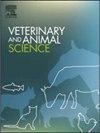Antimicrobial resistance and biofilm-forming ability in Staphylococcus aureus causing clinical bovine mastitis in Chitwan, Nepal
IF 1.9
Q2 AGRICULTURE, DAIRY & ANIMAL SCIENCE
引用次数: 0
Abstract
This cross-sectional study, conducted from August to December 2024, investigated the antimicrobial resistance and biofilm-forming abilities of Staphylococcus aureus from clinical bovine mastitis in Chitwan, Nepal. Out of 134 California Mastitis Test-positive milk samples, 32 (23.9%) were confirmed as S. aureus by biochemical tests and species-specific nuc gene PCR. Antimicrobial susceptibility testing of the 32 isolates against 12 antibiotics revealed high resistance rates, particularly to ampicillin (78.1%), nalidixic acid (75.0%), and enrofloxacin (62.5%). The prevalence of multidrug resistance (MDR), defined as resistance to ≥3 antibiotic classes, was alarmingly high, with 27 (84.4%) isolates classified as MDR. Presumptive methicillin-resistant S. aureus (MRSA), detected via cefoxitin resistance, was identified in 14 (43.8%) isolates, all of which were also MDR. Biofilm-forming abilities were assessed qualitatively and quantitatively, with 5 (15.6%) isolates classified as strong biofilm producers. Fisher’s exact test revealed no significant association between biofilm formation and overall MDR status (p > 0.05). However, a statistically significant correlation was found between strong biofilm formation and high-level MDR (resistance to ≥ 4 classes) (p < 0.05), as well as between strong biofilm formation and presumptive MRSA status (p < 0.01). These findings highlight the co-existence of high-level resistance and strong virulence phenotypes in S. aureus from bovine mastitis in Nepal, underscoring the urgent need for robust antimicrobial stewardship, enhanced surveillance, and the development of strategies to mitigate biofilm-associated treatment failures.
在尼泊尔奇旺引起临床牛乳腺炎的金黄色葡萄球菌的抗微生物药物耐药性和生物膜形成能力
这项横断面研究于2024年8月至12月进行,调查了尼泊尔Chitwan临床牛乳腺炎金黄色葡萄球菌的抗微生物药物耐药性和生物膜形成能力。134份加州乳腺炎试验阳性乳样中,经生化试验和种特异性nuc基因PCR鉴定为金黄色葡萄球菌32份(23.9%)。32株菌株对12种抗生素的药敏试验显示,耐药率较高,其中对氨苄西林(78.1%)、萘啶酸(75.0%)和恩诺沙星(62.5%)耐药率最高。多药耐药(MDR)(定义为对≥3种抗生素的耐药)的患病率高得惊人,有27株(84.4%)被列为MDR。通过对头孢西丁的耐药检测,在14株(43.8%)菌株中发现疑似耐甲氧西林金黄色葡萄球菌(MRSA),均为耐多药。定性和定量评估了生物膜形成能力,其中5株(15.6%)被列为强生物膜生产者。Fisher精确检验显示生物膜形成与总体MDR状态之间无显著关联(p > 0.05)。然而,强生物膜形成与高水平MDR(≥4类耐药)之间存在统计学显著相关性(p < 0.05),强生物膜形成与推定MRSA状态之间存在统计学显著相关性(p < 0.01)。这些发现强调了来自尼泊尔牛乳腺炎的金黄色葡萄球菌的高耐药性和强毒力表型共存,强调了迫切需要强有力的抗菌药物管理、加强监测和制定策略以减轻生物膜相关治疗失败。
本文章由计算机程序翻译,如有差异,请以英文原文为准。
求助全文
约1分钟内获得全文
求助全文
来源期刊

Veterinary and Animal Science
Veterinary-Veterinary (all)
CiteScore
3.50
自引率
0.00%
发文量
43
审稿时长
47 days
 求助内容:
求助内容: 应助结果提醒方式:
应助结果提醒方式:


